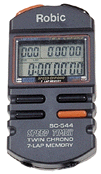Article Topics:
- Overview
- Intro to Racing
- Driving Technique
- Practice Sessions
- Driver’s Gear
- Vehicle Safety
- Handling
- Brakes
- Power
- Tools
TurnFast
recommends
these books:
Articles about Practice Sessions
Recording Lap Times
In solo racing, lap times is what it comes down to, so recording your lap times will be the single most effective data to make notes of. Without the other information, you may not know why, but at least you'll be able to see whether you're going faster or not.
Have someone take and record your lap times. An inexpensive stopwatch with a "lap function" will do. Times can be written down each lap this way. More expensive racing stop watches will store numerous laps allowing them to be written down later (they will also calculate average lap time, average lap speeds, and offer several other useful functions).
Additionally, have the observer make notes each lap as to whether there was traffic involved (did you have to wait for someone, did you slow to allow someone else to pass), or whether you made noticable mistakes. Chances are you'll remember the events, but you may not remember the exact lap they occured on. Correlating the events with lap times will help identify causes for the slow laps. (Besides fast lap times, you'll eventually want to develop consistency, and knowing whether inconsistent times are due to errors or traffic will be important.)
When testing adjustments to the car, lap times are the ultimate determination as to whether the change was better. However, you should use average lap time, not the peak lap times achieved. A single super fast lap of a certain time might have been possible with the other setup as well. What is important for determining the effect of the change is whether it made an improvement the driver was consistently able to utilize. Often in data management practices, the best lap, and the worst lap are thrown out, and the remaining laps are averaged.
Another very useful application of timing is segment times. This is timing not of the whole lap, but of a specific portion, or segment, of the track. For example, if you want to experiment with two different lines through a series of three close corners, have someone time you between the entry to the first, and the exit of the third. Actally, it is often useful to include the entire straight after the last turn. The goal of cornering is to provide the highest exit speed to increase speed on the following straight, so including the straight in the timing magnifies the timing differences between lines.
If you do not have anyone to record your lap times, consider rigging a camcorder in the car that you can review between sessions. Actually, you can learn a lot from an in-car camera, as we discuss in the In-car Video article.
Read Next Article (Tire Notes)

A racing-specific lap timer will store numerous laps, and automatically calculate fastest and average lap speeds among other useful statistics. While not necessary, they sure make recording lap times much easier. You may want to look for one capable of recording split times, or have more than one timer for a couple of trackside friends to use for split times.
